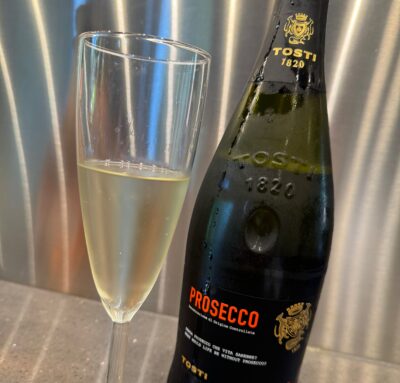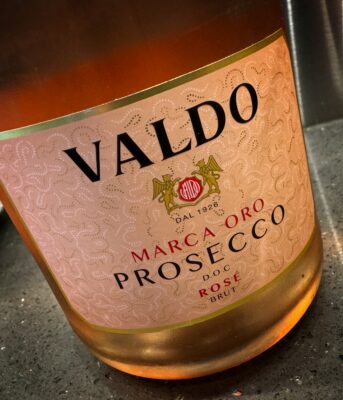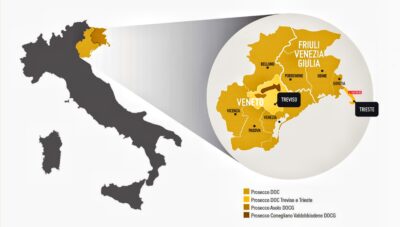
Many of us who have covered the wine industry for decades assume (often incorrectly) that wine consumers are familiar with all the various wine terms, wine regions, sub-regions and methods of fermentation that are assigned to wine in what is now a global marketplace.
Also, when wine drinkers want a sparkling wine they regularly go to a wine shop or market and head straight for the section that says, “Wines of France”, thinking that an expensive Champagne is their only option. Some consumers know, but others do not, that a high quality and value-based alternative for sparkling wines can be found by heading to a different section… “Wines of Italy”. Once there, they only need to look for one word – Prosecco.
Today, we are tasting two excellent examples of Prosecco: TOSTI 1820 Prosecco DOC NV, and (for National Rosé Day), and Valdo Marca Oro Prosecco DOC Rosé Brut 2022

TOSTI 1820 Prosecco DOC NV
This wine was made from the grape variety Glera grown in several provinces in Northern Italy and harvested in early September. Glera is a long-standing synonym of northern Italy’s Prosecco grape, and the name now officially used. The grapes are pressed and the wine is vinified with low-temperature primary fermentation followed by a second fermentation under pressure also at low-temperature in bulk before bottling.
The wine opens with an abundant and persistent froth and a light straw-yellow color with pale green highlights. In the glass, the wine presents delicate aromatic and fruity notes of spring flowers, citrus and pear. This is followed by a mellow, balanced and yet lively palate experience ending in a pleasantly crisp finish. This wine offers a lot of character along at its value price.

Valdo Marca Oro Prosecco DOC Rosé Brut 2022
This is an intriguing product with an eye-catching color and a visual presence – a Rosé version of one of the world’s most popular sparkling wines – Prosecco. In this wine, the Glera (Prosecco) grape is blended with Pinot Noir to create a sparkling Rosé Brut.
Pinot Noir harvested in late-August met with Glera harvested in mid-September to make this wine. The Pinot Noir portion comes from a day of maceration and subsequent soft pressing, and the Glera comes from direct soft pressing. Fermentation occurred at a controlled low-temperature and sparkle added by a second fermentation in bulk and aging for 3 months prior to bottling.
In the glass, the wine presents bright effervescent yet feels soft, smooth and foamy on the palate. Its rose-petal pink color launches a bouquet of florals and delicate fruits, with notes of apple, pear and red raspberries.
Furthermore, since today is National Rosé Day, this is one wine you definitely won’t regret sipping on for the whole day through; Hashtag #RoséAllDay!
In fact, both of these wines offer a lot of character and enjoyment at value prices. They are made for celebration and enjoy whenever you want, or if you believe any occasion needs just a bit more excitement, just pop a cork on Prosecco.
Now let’s get a bit of background to this Prosecco tasting.

Prosecco – A Wine and a Name with History
The first recorded use of the name Prosecco is actually attributed to an Englishman who visited northern Italy in 1593. In his notes, he used the spelling ‘Prosecho’ and wrote, “Here growes [Sic] the wine ‘Pucinum’, now called Prosecho”. He commented it was much celebrated by Pliny the Elder (AD 23/24 – AD 79) who reported that it had medicinal qualities per the wife of Emperor Augustus. The current spelling ‘Prosecco’ appeared for the first time in 1754.

Making Prosecco – Where and What Grapes
The status of Prosecco DOCG is only been given to sparkling wines made in the Valdobbiadene, Cartizze and Asolo areas. However the DOC status comprises sparkling wines made with mostly Glera grapes grown in a wider area made up of 3 regions, Veneto, Trentino and Friuli in northeast of Italy. Sparkling wine made with Glera grapes grown outside the delimited area cannot be called Prosecco. Prosecco Rose is usually made with a small addition of Pinot Noir also grown in the region.

Making Prosecco – Making it Sparkle
Unlike the sparkling wines of Champagne, Prosecco is usually produced using the alternative Charmat (Martinotti) method, in which the secondary fermentation takes place in bulk rather than in each individual bottle. It is also specified that the minimum production time is 30 days. Higher quality Prosecco using this method will ferment the wine for up to 9 months. However, the production rules also allow the use of the ‘Méthode Traditionnelle’ or ‘Méthode Champenoise’ in the Champagne region of France with secondary fermentation in the bottle. In Italy this is known as ‘Metodo Classico’.
Drink up and enjoy!


Be the first to comment